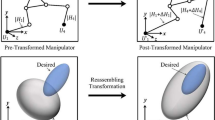Abstract
This paper presents a set of generalized iterative algorithms to find the inverse position kinematics of n-degree-of-freedom kinematic chains with revolute joints. As a first approach, an iterative algorithm is developed using the gradient descent method in Quaternion Algebra to find both the inverse position and velocity kinematics solution in redundant systems closest to their initial configuration. Additionally, a generalized extension of this approach is developed employing screw rotors and Conformal Geometric Algebra, where efficient update rules are obtained to solve the problem of inverse position kinematics. Simulation experiments using different degree-of-freedom models as well as real-time experiments using a Geomagic Touch Haptic device are carried out to demonstrate the effectiveness of the proposed methods.






















Similar content being viewed by others
References
Hamilton W (1866) Elements of quaternions. Green & Co, London
Hart C, Francis K, Kauffman H (1994) Visualizing quaternion rotation. ACM Trans Graph 13(3):256–276
Shoemake K (1985) Animating rotation with quaternion curves. In: Proceedings of the 12th annual conference on computer graphics and interactive techniques, pp 245–254
Featherstone R (1983) Position and velocity transformations between robot end-effector coordinates and joint angles. Int J Robot Res 2(2):35–45
Bayro-Corrochano E, Daniilidis K, Sommer G (2000) Motor algebra for 3D kinematics: The case of the hand-eye calibration. J Math Imag Vis 13(2):79–99
Bayro-Corrochano E, Reyes-Lozano L, Zamora-Esquivel J (2006) Conformal geometric algebra for robotic vision. J Math Imag Vis 24(1):55–81
Macias-Garcia E, Zamora-Esquivel J, Bayro-Corrochano E (2020) Conformal geometric algebra library for MATLAB. https://github.com/iqedgarmg/conformal_library. Accessed 12 Dec 2020
Hamilton W (1853) Lectures on quaternions. Hodges and Smith, Dublin
Bayro-Corrochano E (2020) Geometric algebra application, vol II: Robot modelling and control. Springer, London
Goldman R (2010) Rethinking quaternions. Morgan Claypool 4(1):157–157
Lechuga-Gutierrez L, Medrano-Hermosillo J, Bayro-Corrochano E (2018) Quaternion spiking neural networks control for robotics. In: 2018 IEEE Latin American conference on computational intelligence, pp 1–6
Peijun Y, Keqiang X, Jiancheng L (2011) A design of reconfigurable satellite control system with reaction wheels based on error quaternion model. In: 2011 International conference on internet computing and information services, pp 215–218
Vince J (2016) Mathematics for computer graphics. Springer, London
XiaoLong Y, HongTao W, Yao L, et al (2019) Computationally efficient inverse dynamics of a class of six-DoF parallel robots: Dual quaternion approach. J Intell Robot Sys 94(1):101–113
Cuevas-Jimenez E, Osuna-Enciso J, Oliva-Navarro D (2016) Optimización, algoritmos programados con MATLAB. Alfaomega, México
Curry H (1944) The method of steepest descent for non-linear minimization problems. Quarter Appl Math 2(3):258–261
Jones M (2005) AI application programming. Charles River Media, Massachusetts
Hamming R (1973) Numerical methods for scientists and engineers, 2nd edn. Dover Publications Inc, New York
Fuente J, Santiago J, Román A et al (2014) Handbook on robotics, vol 25. Springer, Berling, pp 1682–1690
Radavelli L, Martins D, De Pieri E, Simoni R (2015) Cinemática posicional de robôs via iteração e quatérnios. Proc Ser Brazilian Soc Comput Appl Math 3(1):1
Bayro-Corrochano E, Zamora-Esquivel J (2007) Differential and inverse kinematics of robot devices using conformal geometric algebra. Robotica 25(1):43–61
Lechuga-Gutierrez L, Macias-Garcia E, Martinez-Terán G, Zamora-Esquivel J, Bayro-Corrochano E (2021) Iterative inverse kinematics for robot manipulators using quaternion algebra and conformal geometric algebra: supplementary material. drive.google.com/drive/folders/11DfFiQ8wZsfY31VDIK2i-Mg0rnHeucCM. Accessed 25 Jun 2021
Kingma D, Ba J (2014) Adam: a method for stochastic optimization. arXiv:1412.6980
Moré J (1978) The Levenberg–Marquardt algorithm: implementation and theory. In: Numerical analysis. Springer, Berlin, pp 105–116
Jarillo-Silva A, Domínguez-Ramírez O, Parra-Vega V, Ordaz-Oliver J (2009) Phantom Omni Haptic device: kinematics and manipulability. In: IEEE electronics, robotics and automotive mechanics conference, pp 193–198
Ogata K (2010) Ingeniería de control moderna. Pearson Education, S.A. Madrid
Acknowledgements
The authors would like to thank CONACYT and CINVESTAV-IPN for the scholarship and the economic and technological support for the realization of this work.
Funding
This work was supported by CONACYT institute and CINVESTAV-IPN.
Author information
Authors and Affiliations
Contributions
All authors contributed to the study conception and design of this work. L. Lechuga-Gutierrez: Paper writing, main contributions in Sects. 2, 3 and 6. E. Macias-Garcia: Paper writing, document review, main contributions in Sects. 2, 4 and 5. G. Martínez-Terán: Main contributions in Sect. 6. J. Zamora-Esquivel: Document review, main contributions in Sects. 4 and 5. E. Bayro-Corrochano: Paper writing, document review, project supervision.
Corresponding author
Ethics declarations
Conflict of interest
The authors have no conflicts of interest to declare that are relevant to the content of this article.
Code availability
The Conformal Geometric Algebra library developed in this work is available at: github.com/iqedgarmg/conformal_library while additional multimedia resources at: drive.google.com/drive/folders/11DfFiQ8wZsfY31VDIK2i-Mg0rnHeucCM.
Ethical approval
Not applicable
Consents to participate
Not applicable
Consent for publication
Not applicable
Additional information
Publisher's Note
Springer Nature remains neutral with regard to jurisdictional claims in published maps and institutional affiliations.
Rights and permissions
About this article
Cite this article
Lechuga-Gutierrez, L., Macias-Garcia, E., Martínez-Terán, G. et al. Iterative inverse kinematics for robot manipulators using quaternion algebra and conformal geometric algebra. Meccanica 57, 1413–1428 (2022). https://doi.org/10.1007/s11012-022-01512-w
Received:
Accepted:
Published:
Issue Date:
DOI: https://doi.org/10.1007/s11012-022-01512-w




